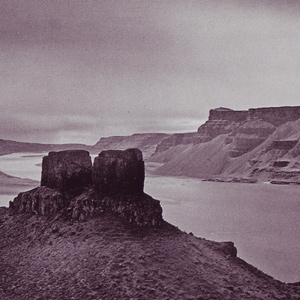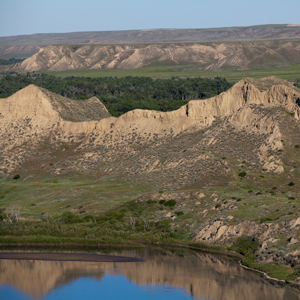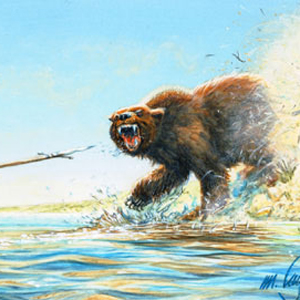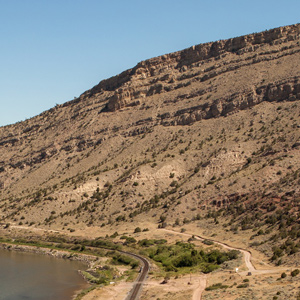Sacagawea appeared in the captains’ journals four times before her name was given. She was with the expedition for just over 16 of the 28 months of the official journey. Speaking both Shoshone and Hidatsa, she served as a link in the communication chain during some crucial negotiations, but was not on the expedition’s payroll. She traveled nearly half the trail carrying her infant on her back. And, despite artistic portrayals of her pointing the way, she ‘guided’ only a few times. Still, Sacagawea remains the third most famous member of the Lewis and Clark Expedition.
Sacagawea Articles


She was with the expedition for just over 16 of the 28 months of the official journey. Speaking both Shoshone and Hidatsa, she served as a link in the communication chain during some crucial negotiations. She remains the third most famous person of the expedition.
The Hidatsa Story of Sakakawea
Alternate spelling, alternate story


This story of Sakakawea (Sacagawea) as told by Bulls Eye to Major Welch circa 1924 provides an alternate version of her life before the expedition. To begin, he says that she was Hidatsa, not Shoshone….


On his return to the mouth of the Marias, Lewis found Sacagawea gravely ill. He had his men cross the river “to procure the water of the Sulpher spring,” “the virtues of which,” Lewis asserted, “I now resolved to try on the Indian woman.”


Of all the near-calamities the Corps of Discovery experienced, none was more dire than the one that occurred on 29 June 1805 in a normally dry ravine a short distance above the Great Fall. The principals were Charbonneau, Sacagawea, Jean Baptiste, York, and William Clark.


“The Indian woman recognized the point of a high plain to our right . . . . This hill she says her nation calls the beaver’s head from a conceived resemblance of its figure to the head of that animal.”


This is the landmark that white settlers believed Sacagawea really meant to identify as Beaverhead Rock . . . .


They encountered several rapids that nineteenth of October, including “a verry bad one” about two miles long. Clark climbed a 200-foot “clift” from which he could see many miles across the high desert.


Sacagawea informed Clark that “she had been in this plain frequently and knew it well,” that the creek they were following was a branch of the Big Hole River, and that “when we assended the higher part of the plain we would discover a gap in the mountains”


Because the Shoshone woman has been the subject of so many sculptures and paintings, especially since about 1900, we have a rich heritage of artists’ conceptions to contemplate.
The Charbonneaus in St. Louis
by Robert J. Moore

In 1809, Toussaint, Sacagawea, and Jean Baptiste Charbonneau traveled to St. Louis. Jean Baptiste’s baptism began a new era in his life, is father would try to become a farmer, and Sacagawea would become sickly.
Sacagawea In the Journals
November 4, 1804
Meeting Charbonneau


The enlisted men continue building Fort Mandan lifting the heavy ceiling beams into place. Fur trader Toussaint Charbonneau visits the site, and the captains hire him as a Hidatsa interpreter.
December 7, 1804
Hunting buffalo


A group of hunters joins with the Mandans, and Sgt. Gass is impressed with their buffalo hunting skills and well-trained horses. By day’s end, several suffer frostbite, and Clark issues half a gill of rum.
January 11, 1805
War medicine dance


Posecopsahe (Black Cat) of Ruptáre and The Coal of Mitutanka visit Fort Mandan and spend the night. At Mitutanka village, several soldiers witness a war medicine dance—perhaps the Mandan Wolf Ceremony.
February 2, 1805
Mr. Larocque's compass


At Fort Mandan, Lewis fixes North West Company trader François-Antoine Larocque’s compass, but latter’s attempt to join the expedition fails. One of the interpreters’ wives—perhaps Sacagawea—is taken ill.
February 7, 1805
Securing the fort


At Fort Mandan, Lewis learns that one of the interpreters’ wives has been letting Indians through the gate during the night. Clark’s party works hard to process and pack fresh deer and elk meat.
February 11, 1805
Baby Charbonneau arrives


At Fort Mandan below the Knife River Villages, Sacagawea gives birth to Jean Baptiste Charbonneau after a tedious and painful labor. Hunting about 40 miles to the south, Clark starts back to the fort.
March 11, 1805
Charbonneau's corruption


At Fort Mandan below the Knife River Villages, the captains accuse Hidatsa interpreter Toussaint Charbonneau of acting in the interests of local fur traders and give him an ultimatum.
April 7, 1805
Leaving Fort Mandan


The permanent party leaves Fort Mandan bound for the Pacific Ocean. They make it only as far as Mitutanka, one of the Knife River Villages. In the barge, the return party heads towards St. Louis.
April 9, 1805
Passing Garrison Bluffs


As the boats move up the Missouri around present Pick City, North Dakota, Sgt. Ordway says the mosquitoes begin to “Suck our blood.” For dinner, Sacagawea collects Jerusalem artichoke bulbs.
April 18, 1805
Head winds


The Charbonneau family joins Clark on shore as the boats struggle against strong headwinds. Lewis takes a turn and sees buffalo wool and the golden pea. Camp is below present Williston, North Dakota.
April 30, 1805
Buffalo currants


While walking on the shore with Clark and Charbonneau, Sacagawea collects a currant bush specimen. After paddling 24 miles up the Missouri, they camp 5 miles southwest of present Brockton, Montana.
May 16, 1805
Sacagawea's fortitude


Early in the morning, a panther appears near their camp in present-day Eastern Montana. Lewis mentions Sacagawea’s “fortitude and resolution” to have saved so many items when the white pirogue upset.
May 20, 1805
"Sâh-câ-gar me-âh or bird woman's River"


The captains name a creek after the flies that congregate on raw meat and fresh wounds. Later in the day, a tributary of the Musselshell is named” Sâh-câ-gar me-âh [Sacagawea] or bird woman’s River”.
June 11, 1805
Lewis scouts ahead


At Decision Point, Clark bleeds Sacagawea. Lewis sets out to find the Great Falls of the Missouri. When he becomes too ill to continue, he makes a healing decoction from the local black chokecherry tree.
June 12, 1805
Searching for the Falls


Clark leads the boats up the Missouri past black bluffs and rattlesnakes nearly reaching present Fort Benton. Lewis has several adventures as he searches for the Great Falls of the Missouri.
June 13, 1805
"sublimely grand specticle"


At the Grand Fall, Lewis marvels at the “sublimely grand specticle”. Downriver, Clark gives Sacagawea a dose of salts. At Fort Massac, General Wilkinson has questions about the people sent to him in the barge.
June 14, 1805
A great many falls


At the Falls of the Missouri, Lewis finds a continuous series of waterfalls and a combative grizzly bear. Clark and the boats struggle to make ten more miles and Sacagawea’s illness becomes “Somewhat dangerous”.
June 15, 1805
Sacagawea deteriorates


Below the Great Falls of the Missouri, Sacagawea‘s health deteriorates, and Charbonneau asks her to return home. Several miles ahead, Lewis fishes and describes a prairie rattlesnake in minute detail.


Clark establishes a camp at the beginning of the portage around the Great Falls of the Missouri. Lewis returns to find Sacagawea seriously ill. He gives her medicine and water from Sulpher Spring.
June 17, 1805
Preparing the portage


Clark surveys a route for the upcoming portage while five dugouts are walked up Belt Creek. Six men prepare wheels to cart the heavy boats around the Falls of the Missouri, and Sacagawea’s health improves.
June 18, 1805
Great fall views


Clark finishes mapping the Falls of the Missouri and continues to the end of the portage where Willard is attacked by a grizzly bear. At Lower Portage Camp, the men prepare the portage and Sacagawea recovers.
June 19, 1805
Sacagawea relapses


Below the Great Falls of the Missouri, the men prepare for the portage and Sacagawea relapses. At the White Bear Islands, Clark determines he will find the best route to haul the heavy dugout canoes.
June 20, 1805
Planning the portage


Clark plans a portage route around the Great Falls of the Missouri and is stumped as to where to cross present-day Box Elder Creek. At Lower Portage Camp, Lewis has the men build a store of bison meat.
June 22, 1805
Portaging the first dugout


A large group hauls the first dugout canoe around the Great Falls of the Missouri. The wagon needs frequent repairs, and after dark, they abandon the heavy boat and hike the remaining ½ mile.
June 29, 1805
A flash flood


Hail and rain disrupt the portage around the Falls of the Missouri. Baggage is left on the plain, men are bruised and bloody, and Sacagawea and her baby are nearly swept away in a flash flood.
July 13, 1805
Leaving the Great Falls


Lewis and the last of the crew leave the White Bear Islands above the Great Falls of the Missouri. At the canoe-making camp near present Ulm, Clark has “an emensity of meat” dried to make pemmican.
July 22, 1805
Sacagawea's recognition


While waiting for the boats near present Beaver Creek in the Helena Valley, Lewis dives into the Missouri to retrieve a wounded river otter. Everyone is encouraged when Sacagawea recognizes the area.
July 24, 1805
Turned side upwards


Scouting ahead, Clark sees hills “fallen half down & turned Side up-wards”. The boats pass the Crimson Bluffs, Sacagawea assures Lewis the river will remain navigable, and they camp at Yorks Islands.
July 28, 1805
Sacagawea's capture


At the headwaters of the Missouri, the expedition takes a rest day. The captains learn of Sacagawea‘s capture as a young child, and Lewis remarks on how she “would be perfectly content anywhere”.
August 8, 1805
Beaverhead Rock in view


Sacagawea recognizes “the beaver’s head” and informs the captains that the summer home of her people is not far ahead. The men poling the canoes find the Beaverhead River is gentler than the Big Hole.
August 14, 1805
Asking for Shoshone help


On the Lemhi River, Lewis asks Cameahwait to help bring the expedition’s baggage over the Continental Divide. On the Beaverhead River, Clark reprimands Toussaint Charbonneau for striking Sacagawea.
August 16, 1805
Too many worries


By night, the boats are within a day’s travel to Fortunate Camp. Already there, Lewis worries about the fate of the expedition. With him, the Lemhi Shoshones worry that they have been led into a trap.
August 17, 1805
Fortunate Camp reunions


Clark and the boats reach Lewis and the Lemhi Shoshones at the end of the Beaverhead River. Sacagawea is reunited with old friends and family, and negotiations for horses commences.
August 18, 1805
Searching for a navigable river


Clark commands a group bound for a navigable branch of the Columbia River. They and several Lemhi Shoshones cross Shoshone Cove east of Lemhi Pass. At Fortunate Camp, Lewis writes a melancholy meditation.
August 19, 1805
Clark crosses Lemhi Pass


Clark and several Shoshones cross Lemhi Pass and camp on Pattee Creek. At Fortunate Camp, Lewis starts a multi-day treatise describing the Lemhi Shoshones, and Charbonneau must pay for Sacagawea.
August 22, 1805
Shoshone foods


The journalists encounter several staple foods of the Lemhi Shoshones. Clark camps on a small island in the Salmon River and sees a bird new to science. Cameahwait’s People arrive at Fortunate Camp.
August 24, 1805
Leaving Fortunate Camp


Lewis barters for three horses and a mule, Charbonneau buys Sacagawea a horse, and they and several Shoshone women head towards Lemhi Pass. On the Salmon River, Clark considers their options.
October 12, 1805
Snake River rapids


The paddlers make about thirty miles down the Snake River in present Washington. Gass describes Palouse villages, and Clark finds Sacagawea “reconsiles all the Indians, as to our friendly intentions”.
October 19, 1805
The Walla Walla and Umatillas


After passing Hat Rock in the Wallula Gap, Clark frightens several Umatillas who—after seeing Sacagawea—learn he is not part of a war party. The day ends with mutual smoking and fiddle music.
November 3, 1805
The "Quick Sand" River


Moving down the Columbia River above present Portland, Oregon, Clark is unable to cross a river full of quicksand—today’s Sandy River. They continue to a large island full of ponds and waterfowl.
November 8, 1805
Seasick paddlers


Moving down the Columbia, the wet weather continues. While crossing Grays Bay, high waves force the dugout canoes to stay close to shore. They cross safely but arrive with several seasick paddlers.
November 20, 1805
Sacagawea's belt of blue beads


At Station Camp on present Baker Bay, the captains meet with Chiefs Concomly and Shelathwell. Another Indian trades two sea otter skins for Sacagawea‘s belt of blue beads, and she is given a new coat.
April 28, 1806
Yelleppit brings a horse


Across from the Walla Walla River, talks begin with Sacagawea and Charbonneau as interpreters. Yelleppit brings Clark a horse, Clark gives medical aid, and Pvt. Frazer buys ten fat dogs for consumption.
May 5, 1806
Clark's eye water magic


On the Clearwater River, the Captains discover that Clark’s eye water can be traded for food and horses. A Nez Perce man tosses a puppy at Lewis who fails to see the humor. Camp is at Colters Creek—present Potlatch River.
May 16, 1806
Dispelling winds


At Long Camp, the Captains’ mess eats yampah and onions gathered by Sacagawea to help dispel the wind caused from digesting camas and cous roots. John Shields brings Lewis a woodpecker new to science.
July 3, 1806
Splitting up


Lewis heads north spending most of the day rafting baggage across present Clark Fork west of Missoula, Montana. Clark’s group heads south along the west side of the Bitterroot River.
July 6, 1806
Approaching the Rockies


In their separate groups, the captains approach the Rocky Mountains. Clark crosses the divide and camps in the Big Hole Valley. Lewis crosses a prairie of knobs and camps near Lincoln, Montana.
July 9, 1806
Feasting on buffalo


Lewis nears the Great Falls of the Missouri feasting on buffalo, the first since 16 July 1805. At Fortunate Camp, Clark’s group prepares the dugout canoes, and Sgt. Ordway arrives with the stray horses.
July 13, 1806
Two groups become three


At the Falls of the Missouri, Lewis finds last year’s cache has flooded. At the headwaters of the Missouri, Sgt. Ordway takes the canoes down the Missouri, and Clark heads up the Gallatin River valley by horse.
July 14, 1806
Sacagawea knows a way


At the Great Falls of the Missouri, Lewis has the wheels and iron-framed boat dug up. Clark mires in Gallatin River swamps before finding an old bison trace. Sgt. Ordway‘s group paddles to Yorks Islands.
July 17, 1806
Signs of danger


Between the Falls of the Missouri and the Marias River, Lewis sees signs of Indian hunters. On the Yellowstone, Clark passes an “Indian Fort”. Sgt. Ordway runs Pine Tree Rapids and Sgt. Gass waits above the falls.
August 9, 1806
Sacagawea gathers currants


Near Tobacco Garden Creek, Sacagawea gather currants while Clark’s group moves their boats down the Missouri. Near present Williston, Lewis stops to make clothes, and two of his lost hunters catch up.
August 17, 1806
An offer to raise Jean Baptiste


The expedition leaves the Knife River Villages without Pvt. Colter and the Charbonneau family. Clark encourages the Charbonneaus to come to St. Louis where he can arrange the education of Jean Baptiste.
Experience the Lewis and Clark Trail
The Lewis and Clark Trail Experience—our sister site at lewisandclark.travel—connects the world to people and places on the Lewis and Clark Trail.
Discover More
- The Lewis and Clark Expedition: Day by Day by Gary E. Moulton (University of Nebraska Press, 2018). The story in prose, 14 May 1804–23 September 1806.
- The Lewis and Clark Journals: An American Epic of Discovery (abridged) by Gary E. Moulton (University of Nebraska Press, 2003). Selected journal excerpts, 14 May 1804–23 September 1806.
- The Lewis and Clark Journals. by Gary E. Moulton (University of Nebraska Press, 1983–2001). The complete story in 13 volumes.

